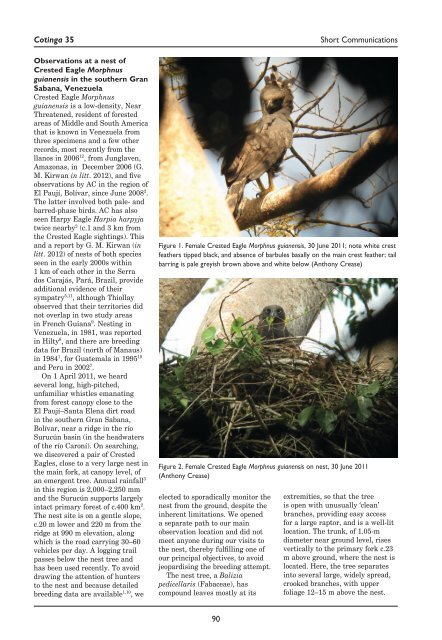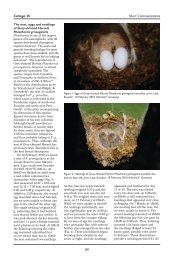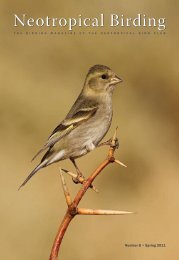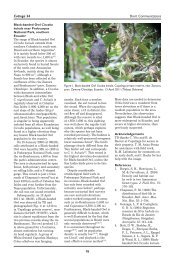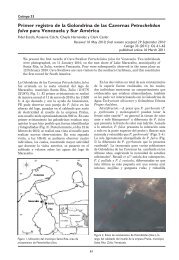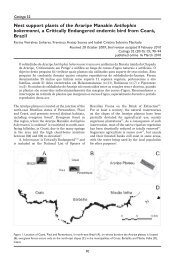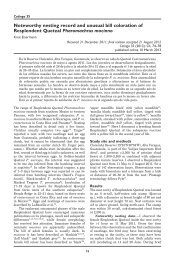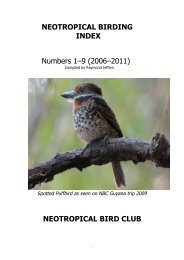Observations at a nest of Crested Eagle Morphnus guianensis in the ...
Observations at a nest of Crested Eagle Morphnus guianensis in the ...
Observations at a nest of Crested Eagle Morphnus guianensis in the ...
Create successful ePaper yourself
Turn your PDF publications into a flip-book with our unique Google optimized e-Paper software.
Cot<strong>in</strong>ga 35<strong>Observ<strong>at</strong>ions</strong> <strong>at</strong> a <strong>nest</strong> <strong>of</strong><strong>Crested</strong> <strong>Eagle</strong> <strong>Morphnus</strong><strong>guianensis</strong> <strong>in</strong> <strong>the</strong> sou<strong>the</strong>rn GranSabana, Venezuela<strong>Crested</strong> <strong>Eagle</strong> <strong>Morphnus</strong><strong>guianensis</strong> is a low-density, NearThre<strong>at</strong>ened, resident <strong>of</strong> forestedareas <strong>of</strong> Middle and South Americ<strong>at</strong>h<strong>at</strong> is known <strong>in</strong> Venezuela fromthree specimens and a few o<strong>the</strong>rrecords, most recently from <strong>the</strong>llanos <strong>in</strong> 2006 12 , from Junglaven,Amazonas, <strong>in</strong> December 2006 (G.M. Kirwan <strong>in</strong> litt. 2012), and fiveobserv<strong>at</strong>ions by AC <strong>in</strong> <strong>the</strong> region <strong>of</strong>El Paují, Bolívar, s<strong>in</strong>ce June 2008 2 .The l<strong>at</strong>ter <strong>in</strong>volved both pale- andbarred-phase birds. AC has alsoseen Harpy <strong>Eagle</strong> Harpia harpyj<strong>at</strong>wice nearby 2 (c.1 and 3 km from<strong>the</strong> <strong>Crested</strong> <strong>Eagle</strong> sight<strong>in</strong>gs). Thisand a report by G. M. Kirwan (<strong>in</strong>litt. 2012) <strong>of</strong> <strong>nest</strong>s <strong>of</strong> both speciesseen <strong>in</strong> <strong>the</strong> early 2000s with<strong>in</strong>1 km <strong>of</strong> each o<strong>the</strong>r <strong>in</strong> <strong>the</strong> Serrados Carajás, Pará, Brazil, provideadditional evidence <strong>of</strong> <strong>the</strong>irsymp<strong>at</strong>ry 5,11 , although Thiollayobserved th<strong>at</strong> <strong>the</strong>ir territories didnot overlap <strong>in</strong> two study areas<strong>in</strong> French Guiana 9 . Nest<strong>in</strong>g <strong>in</strong>Venezuela, <strong>in</strong> 1981, was reported<strong>in</strong> Hilty 6 , and <strong>the</strong>re are breed<strong>in</strong>gd<strong>at</strong>a for Brazil (north <strong>of</strong> Manaus)<strong>in</strong> 1984 1 , for Gu<strong>at</strong>emala <strong>in</strong> 1995 10and Peru <strong>in</strong> 2002 7 .On 1 April 2011, we heardseveral long, high-pitched,unfamiliar whistles eman<strong>at</strong><strong>in</strong>gfrom forest canopy close to <strong>the</strong>El Paují–Santa Elena dirt road<strong>in</strong> <strong>the</strong> sou<strong>the</strong>rn Gran Sabana,Bolívar, near a ridge <strong>in</strong> <strong>the</strong> ríoSurucún bas<strong>in</strong> (<strong>in</strong> <strong>the</strong> headw<strong>at</strong>ers<strong>of</strong> <strong>the</strong> río Caroní). On search<strong>in</strong>g,we discovered a pair <strong>of</strong> <strong>Crested</strong><strong>Eagle</strong>s, close to a very large <strong>nest</strong> <strong>in</strong><strong>the</strong> ma<strong>in</strong> fork, <strong>at</strong> canopy level, <strong>of</strong>an emergent tree. Annual ra<strong>in</strong>fall 3<strong>in</strong> this region is 2,000–2,250 mmand <strong>the</strong> Surucún supports largely<strong>in</strong>tact primary forest <strong>of</strong> c.400 km 2 .The <strong>nest</strong> site is on a gentle slope,c.20 m lower and 220 m from <strong>the</strong>ridge <strong>at</strong> 990 m elev<strong>at</strong>ion, alongwhich is <strong>the</strong> road carry<strong>in</strong>g 30–60vehicles per day. A logg<strong>in</strong>g trailpasses below <strong>the</strong> <strong>nest</strong> tree andhas been used recently. To avoiddraw<strong>in</strong>g <strong>the</strong> <strong>at</strong>tention <strong>of</strong> huntersto <strong>the</strong> <strong>nest</strong> and because detailedbreed<strong>in</strong>g d<strong>at</strong>a are available 1,10 , weShort Communic<strong>at</strong>ionsFigure 1. Female <strong>Crested</strong> <strong>Eagle</strong> <strong>Morphnus</strong> <strong>guianensis</strong>, 30 June 2011; note white crestfe<strong>at</strong>hers tipped black, and absence <strong>of</strong> barbules basally on <strong>the</strong> ma<strong>in</strong> crest fe<strong>at</strong>her; tailbarr<strong>in</strong>g is pale greyish brown above and white below (Anthony Crease)Figure 2. Female <strong>Crested</strong> <strong>Eagle</strong> <strong>Morphnus</strong> <strong>guianensis</strong> on <strong>nest</strong>, 30 June 2011(Anthony Crease)elected to sporadically monitor <strong>the</strong><strong>nest</strong> from <strong>the</strong> ground, despite <strong>the</strong><strong>in</strong>herent limit<strong>at</strong>ions. We openeda separ<strong>at</strong>e p<strong>at</strong>h to our ma<strong>in</strong>observ<strong>at</strong>ion loc<strong>at</strong>ion and did notmeet anyone dur<strong>in</strong>g our visits to<strong>the</strong> <strong>nest</strong>, <strong>the</strong>reby fulfill<strong>in</strong>g one <strong>of</strong>our pr<strong>in</strong>cipal objectives, to avoidjeopardis<strong>in</strong>g <strong>the</strong> breed<strong>in</strong>g <strong>at</strong>tempt.The <strong>nest</strong> tree, a Baliziapedicellaris (Fabaceae), hascompound leaves mostly <strong>at</strong> itsextremities, so th<strong>at</strong> <strong>the</strong> treeis open with unusually ‘clean’branches, provid<strong>in</strong>g easy accessfor a large raptor, and is a well-litloc<strong>at</strong>ion. The trunk, <strong>of</strong> 1.05-mdiameter near ground level, risesvertically to <strong>the</strong> primary fork c.23m above ground, where <strong>the</strong> <strong>nest</strong> isloc<strong>at</strong>ed. Here, <strong>the</strong> tree separ<strong>at</strong>es<strong>in</strong>to several large, widely spread,crooked branches, with upperfoliage 12–15 m above <strong>the</strong> <strong>nest</strong>.90
Cot<strong>in</strong>ga 35Figure 3. Unfledged young <strong>Crested</strong> <strong>Eagle</strong> <strong>Morphnus</strong> <strong>guianensis</strong>, c.105 days <strong>of</strong> age, 30August 2011 (Anthony Crease)Figure 4. Juvenile <strong>Crested</strong> <strong>Eagle</strong> <strong>Morphnus</strong> <strong>guianensis</strong> <strong>in</strong> <strong>nest</strong> tree post-fledg<strong>in</strong>g, c.133days old, 27 September 2007 (Anthony Crease)Most trees around <strong>the</strong> <strong>nest</strong> havecrowns below c.24 m with a moreopen area and lower growth c.70m to <strong>the</strong> north-west, and an oldtreefall c.40 m to <strong>the</strong> south. The<strong>nest</strong> is higher than most adjacenttrees, particularly those downslope<strong>the</strong>reby provid<strong>in</strong>g a wide view over<strong>the</strong> canopy to <strong>the</strong> north, whichdirection was normally used by <strong>the</strong>eagles for take-<strong>of</strong>f. The <strong>nest</strong> wasc.1 m <strong>in</strong> diameter, 0.8 m deep, andcomprised sticks up to c.3 cm <strong>in</strong>diameter, with lianas grow<strong>in</strong>g on<strong>the</strong> sides, possibly orig<strong>in</strong><strong>at</strong><strong>in</strong>g fromleafy lianas brought by <strong>the</strong> eagles(Fig. 2). Such ‘adorn<strong>in</strong>g’ <strong>of</strong> <strong>the</strong> <strong>nest</strong>with greenery has been reportedpreviously 1 .We visited <strong>the</strong> <strong>nest</strong> on 22occasions between 1 April and 1November 2011, for a total <strong>of</strong> 70hours, <strong>in</strong>clud<strong>in</strong>g some day-longvisits. We were unable to preciselydeterm<strong>in</strong>e <strong>the</strong> d<strong>at</strong>es <strong>of</strong> lay<strong>in</strong>g andh<strong>at</strong>ch<strong>in</strong>g. However, we did observeShort Communic<strong>at</strong>ions<strong>the</strong> young eagle’s first flightsand could <strong>the</strong>refore estim<strong>at</strong>e <strong>the</strong>h<strong>at</strong>ch<strong>in</strong>g d<strong>at</strong>e as 17 May, basedon 114 days to fledg<strong>in</strong>g 10 . Bycompar<strong>in</strong>g our own observ<strong>at</strong>ionswith 11 developmental milestonesprovided by Whitacre et al. 10 ,we can confirm 17 May as a fairestim<strong>at</strong>e <strong>of</strong> h<strong>at</strong>ch<strong>in</strong>g d<strong>at</strong>e. Lay<strong>in</strong>gand commencement <strong>of</strong> brood<strong>in</strong>goccurred between 1 and 15 April,consistent with <strong>the</strong> <strong>in</strong>cub<strong>at</strong>ionperiod <strong>of</strong> 40–50 days assumed byBierregaard 1 .We first saw <strong>the</strong> young eagleon 30 June, <strong>at</strong> c.44 days <strong>of</strong> age (itwas not seen on days 10, 13, 21and 28). On 30 June <strong>the</strong> femalewas away from <strong>the</strong> <strong>nest</strong> for 80%<strong>of</strong> <strong>the</strong> day, <strong>in</strong>clud<strong>in</strong>g a period<strong>of</strong> 30 m<strong>in</strong>utes <strong>of</strong> light ra<strong>in</strong>fall.In lowland Gu<strong>at</strong>emala 10 , <strong>the</strong>female only left <strong>the</strong> young alone<strong>at</strong> 59 days. It is probable th<strong>at</strong>this difference reflects <strong>the</strong> coolerclim<strong>at</strong>e (and considerably higherelev<strong>at</strong>ion) <strong>of</strong> our site, reliev<strong>in</strong>g <strong>the</strong>female <strong>of</strong> <strong>the</strong> need to shade <strong>the</strong>young earlier <strong>in</strong> its development.Development <strong>of</strong> <strong>the</strong> young andadult behaviour was o<strong>the</strong>rwisesimilar to those <strong>in</strong> lowlandGu<strong>at</strong>emala, with two exceptions.Firstly, <strong>the</strong> young appeared lessexcitable (e.g., less jump<strong>in</strong>g dur<strong>in</strong>gw<strong>in</strong>g exercis<strong>in</strong>g and less reactionto over-fly<strong>in</strong>g vultures and o<strong>the</strong>rlarge birds) and secondly, andmore significantly, we observed<strong>the</strong> female withhold food from<strong>the</strong> young for many hours, dur<strong>in</strong>gconsecutive full-day visits 81and 99 days after estim<strong>at</strong>edh<strong>at</strong>ch<strong>in</strong>g, which behaviour has notpreviously been reported <strong>in</strong> <strong>the</strong>liter<strong>at</strong>ure.At 81 days, <strong>the</strong> female left <strong>the</strong><strong>nest</strong> area <strong>at</strong> 06h12, was seensoar<strong>in</strong>g overhead <strong>at</strong> 10h30 andreturned to <strong>the</strong> <strong>nest</strong> <strong>at</strong> 11h08,rema<strong>in</strong><strong>in</strong>g <strong>in</strong> <strong>the</strong> environswithout a break <strong>of</strong> more than 15m<strong>in</strong>utes until 14h13. Additionally,dur<strong>in</strong>g this period, <strong>the</strong> youngmade begg<strong>in</strong>g whistles almostconstantly, aga<strong>in</strong> imply<strong>in</strong>g <strong>the</strong>adult’s cont<strong>in</strong>uous presence. At13h16 <strong>the</strong> female was seen with aWoolly Mouse Opossum Micoureusdemerarae, presumably captureddur<strong>in</strong>g <strong>the</strong> period <strong>of</strong> absence priorto 11h08. However, <strong>the</strong> prey was91
Cot<strong>in</strong>ga 35Short Communic<strong>at</strong>ions5. Normal whistles <strong>of</strong> adults; note slightly lower pitched 6. Long double whistle7. Long s<strong>in</strong>gle whistle <strong>of</strong> femalewhistle <strong>of</strong> a second distant eagle <strong>at</strong> boom right<strong>of</strong> femalewith short <strong>in</strong>troductory notesBegg<strong>in</strong>g whistle<strong>of</strong> eaglet <strong>at</strong> 28 daysHigh-pitched, short doublewhistle<strong>of</strong> female, weeyuh8. Begg<strong>in</strong>g whistle 9. Whistles <strong>of</strong> eaglet aer fledg<strong>in</strong>g (133 days);<strong>of</strong> eaglet <strong>at</strong> 81 days ignore lower trace (<strong>in</strong>sect)Figure 5 ‘Normal whistles’, three from one bird (probably <strong>the</strong> female), two from <strong>the</strong> o<strong>the</strong>r <strong>at</strong> slightly lower pitch.Figure 6. Long doubled whistle from female.Figure 7. Variant <strong>of</strong> female’s long whistle with <strong>in</strong>troductory ‘squeal’, which is also commonly given alone.Figure 8. Begg<strong>in</strong>g whistle <strong>of</strong> young <strong>at</strong> 81 days.Figure 9. Whistles <strong>of</strong> post-fledged young <strong>at</strong> 133 days.All record<strong>in</strong>gs made with EDIROL R-09HR and Sennheiser ME-67 microphone by Anthony Crease; s<strong>of</strong>tware: Wavesurfer.not delivered to <strong>the</strong> young untilnearly 16h58. Dur<strong>in</strong>g this period<strong>the</strong> female landed and quicklytook <strong>of</strong>f from <strong>the</strong> <strong>nest</strong> on sevenoccasions without deposit<strong>in</strong>g<strong>the</strong> prey, despite <strong>the</strong> <strong>nest</strong>l<strong>in</strong>g’sbegg<strong>in</strong>g; and also whistledsporadically from nearby, caus<strong>in</strong>g<strong>the</strong> pullus to redouble its begg<strong>in</strong>gcalls. The eventual delivery justpermitted <strong>the</strong> young to feed beforedusk. Similar behaviour wasobserved 18 days l<strong>at</strong>er, when anunidentified large b<strong>at</strong>rachian waswithheld for c.4 hours. Wh<strong>at</strong>ever<strong>the</strong> reason for this behaviour,it appears th<strong>at</strong> o<strong>the</strong>r factorsthan maximum weight ga<strong>in</strong>,which would best be achieved byfeed<strong>in</strong>g <strong>the</strong> young rapidly, arefunction<strong>in</strong>g.The female did not <strong>in</strong>cub<strong>at</strong>e<strong>the</strong> egg or rema<strong>in</strong> with <strong>the</strong> youngcont<strong>in</strong>uously, but took shortabsences when it was warm or<strong>the</strong> <strong>nest</strong> was sunlit. However, shewas always present early <strong>in</strong> <strong>the</strong>morn<strong>in</strong>g prior to h<strong>at</strong>ch<strong>in</strong>g andwhen <strong>the</strong> young was
Cot<strong>in</strong>ga 35fe<strong>at</strong>her was devoid <strong>of</strong> barbs forc.30% <strong>of</strong> its length, perhaps dueto wear as it is pushed to and frobetween <strong>the</strong> shorter crest fe<strong>at</strong>herswhen rot<strong>at</strong><strong>in</strong>g <strong>the</strong> head <strong>in</strong> w<strong>in</strong>dyconditions (Fig. 1). Loss <strong>of</strong> barbswas not observed <strong>in</strong> <strong>the</strong> juvenile<strong>at</strong> 19 weeks, support<strong>in</strong>g <strong>the</strong>hypo<strong>the</strong>sis <strong>of</strong> wear as <strong>the</strong> cause<strong>of</strong> loss.Vocalis<strong>at</strong>ions comprise whistles<strong>of</strong> variable length, separ<strong>at</strong>ionand pitch p<strong>at</strong>tern, and alwaysshow a second, and sometimesalso a fa<strong>in</strong>t third, harmonic. On1 April 2011, when both adultswere <strong>at</strong> <strong>the</strong> <strong>nest</strong> prior to lay<strong>in</strong>g,<strong>the</strong>y uttered similar whistles(‘normal whistles’), <strong>of</strong> 1.0–1.4seconds dur<strong>at</strong>ion, <strong>the</strong>ir pitch ris<strong>in</strong>gslightly to a peak <strong>of</strong> 2.7–3.0 kHz,<strong>the</strong>n fall<strong>in</strong>g slightly, wiieeeuh(Fig. 5). In <strong>the</strong> sonogram, threeloud whistles by one bird andtwo fa<strong>in</strong>ter ones by <strong>the</strong> o<strong>the</strong>r <strong>at</strong>slightly lower pitch and longerspac<strong>in</strong>g are visible. The louderwhistles are probably from <strong>the</strong>female, which appears strongervoiced, based on our cumul<strong>at</strong>iveexperience. The female also madeloud and much longer (2.5–3.6seconds) whistles <strong>of</strong> similarpitch and p<strong>at</strong>tern on 6 July 2011(Fig. 6). Whe<strong>the</strong>r this reflectedwarn<strong>in</strong>g or alarm is unclear.The whistles were mostly givendoubled with <strong>the</strong> second somewh<strong>at</strong>shorter (75%). A variant <strong>of</strong> <strong>the</strong>long whistle was also recorded<strong>in</strong> which <strong>the</strong> pitch dropped veryslightly through 3 kHz and waspreceded by a short (0.38-seconds)high-pitched, bisyllabic squeal,skee’yuh (Fig. 7), which rises from4 to 6 kHz, before fall<strong>in</strong>g. Thissqueal was also commonly givenalone.Begg<strong>in</strong>g whistles <strong>of</strong> <strong>the</strong>young <strong>at</strong> 81 days are short (0.35seconds), see Fig. 8, and have acharacteristic p<strong>at</strong>tern, which peaksearly <strong>at</strong> 5.5 kHz and <strong>the</strong>n falls,rises and falls to c.4.5 kHz; tsiu.They are similar to those recorded<strong>at</strong> 50 days and appear to be an<strong>at</strong>tempt to reproduce <strong>the</strong> adult’s‘squeal’. These begg<strong>in</strong>g whistleswere given <strong>in</strong> bouts <strong>of</strong> 3–10 with1–2 seconds between whistles. Aspreviously reported 10 , <strong>the</strong> youngappeared only to beg when <strong>the</strong>adults were <strong>in</strong> view or audible, andwas o<strong>the</strong>rwise silent. At 19 daysafter fledg<strong>in</strong>g, <strong>the</strong> juvenile gavea different whistle (presumablynot begg<strong>in</strong>g as <strong>the</strong> adults wereabsent), similar <strong>in</strong> p<strong>at</strong>tern to <strong>the</strong>‘normal’ whistles <strong>of</strong> adults, buthigher and shorter, twee (Fig. 9).AcknowledgementsWe thank Mario Gabaldónand Pierre Perret for help<strong>in</strong>gto identify <strong>the</strong> <strong>nest</strong> tree, RobBierregaard for his comments on<strong>the</strong> submitted manuscript and GuyKirwan for many suggestions andimprovements to <strong>the</strong> same.References1. Bierregaard, R. O. (1984)<strong>Observ<strong>at</strong>ions</strong> <strong>of</strong> <strong>the</strong> breed<strong>in</strong>g<strong>of</strong> <strong>the</strong> Guiana <strong>Crested</strong> <strong>Eagle</strong><strong>Morphnus</strong> <strong>guianensis</strong>. WilsonBull. 96: 1–5.2. Crease, A. B. (2009) Avianrange extensions from <strong>the</strong>sou<strong>the</strong>rn headw<strong>at</strong>ers <strong>of</strong> <strong>the</strong>río Caroní, Gran Sabana,Bolívar, Venezuela. Cot<strong>in</strong>ga31: 5–19.3. Corporación Venezolana deGuayana-Electrificacióndel Caroní (CVG-EDELCA)(2004) La cuenca del ríoCaroní: una visión en cifras.Caracas: CVG-EDELCA.4. Ferguson-Lees, J. & Christie,D. A. (2005) Raptors <strong>of</strong><strong>the</strong> world. Pr<strong>in</strong>ceton, NJ:Pr<strong>in</strong>ceton University Press.5. Global Raptor Inform<strong>at</strong>ionNetwork (2011) Speciesaccount: <strong>Crested</strong> <strong>Eagle</strong><strong>Morphnus</strong> <strong>guianensis</strong>. www.globalraptors.org (accessed 7July 2011).6. Hilty, S. L. (2003) Birds <strong>of</strong>Venezuela. Pr<strong>in</strong>ceton, NJ:Pr<strong>in</strong>ceton University Press.Short Communic<strong>at</strong>ions7. Ra<strong>in</strong>e, A. F. (2007) Breed<strong>in</strong>gbird records from <strong>the</strong>Tambop<strong>at</strong>a-CandamoReserve Zone, Madre de Dios,south-east Peru. Cot<strong>in</strong>ga 28:53–58.8. Restall, R., Rodner C. &Lent<strong>in</strong>o, M. (2006) Birds <strong>of</strong>nor<strong>the</strong>rn South America.London, UK: ChristopherHelm.9. Thiollay, J. M. (1989) Arearequirements for <strong>the</strong>conserv<strong>at</strong>ion <strong>of</strong> ra<strong>in</strong> forestraptors and game birds <strong>in</strong>French Guiana. Conserv.Biol. 3: 128–137.10. Whitacre, D. F., Lopez Avila,J. & Lopez Avila, G. (2002)Behavioral and physicaldevelopment <strong>of</strong> a <strong>nest</strong>l<strong>in</strong>g<strong>Crested</strong> <strong>Eagle</strong> <strong>Morphnus</strong><strong>guianensis</strong>. J. Raptor Res.36: 77–81.11. Vargas-González, J. de J.,Mosquera, R. & W<strong>at</strong>son,M. (2006) <strong>Crested</strong> <strong>Eagle</strong><strong>Morphnus</strong> <strong>guianensis</strong> feed<strong>in</strong>ga postfledged young Harpy<strong>Eagle</strong> Harpia harpyja <strong>in</strong>Panama. Orn. Neotrop. 17:581–584.12. Vargas-González, J. de J., RiosUzcátegui, G. A., SerranoMar<strong>in</strong>, J. J., Cancion Arias,M. J. & Briceño David, E.J. (2010) Primer registro deÁguila Crestada <strong>Morphnus</strong><strong>guianensis</strong> en los llanosoccidentales de Venezuela.Cot<strong>in</strong>ga 32: 160–161.Anthony Crease andIvan Teped<strong>in</strong>oEl Pauji, Ofic<strong>in</strong>a de CorreosIpostel, Santa Elena de Uairén,Estado Bolívar, Venezuela.E-mails: trcrease@gmail.com andivantepui@yahoo.com.Received 1 November 2011; f<strong>in</strong>alrevision accepted 31 July 2012;published onl<strong>in</strong>e 10 March 201393


